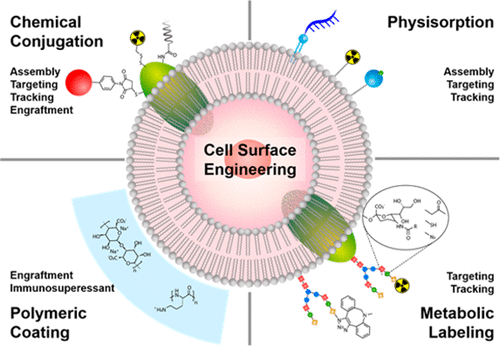当前位置:
X-MOL 学术
›
Chem. Rev.
›
论文详情
Our official English website, www.x-mol.net, welcomes your
feedback! (Note: you will need to create a separate account there.)
Engineering the Surface of Therapeutic “Living” Cells
Chemical Reviews ( IF 51.4 ) Pub Date : 2018-01-16 00:00:00 , DOI: 10.1021/acs.chemrev.7b00157 Jooyeon Park , Brenda Andrade , Yongbeom Seo , Myung-Joo Kim 1 , Steven C Zimmerman , Hyunjoon Kong
Chemical Reviews ( IF 51.4 ) Pub Date : 2018-01-16 00:00:00 , DOI: 10.1021/acs.chemrev.7b00157 Jooyeon Park , Brenda Andrade , Yongbeom Seo , Myung-Joo Kim 1 , Steven C Zimmerman , Hyunjoon Kong
Affiliation

|
Biological cells are complex living machines that have garnered significant attention for their potential to serve as a new generation of therapeutic and delivery agents. Because of their secretion, differentiation, and homing activities, therapeutic cells have tremendous potential to treat or even cure various diseases and injuries that have defied conventional therapeutic strategies. Therapeutic cells can be systemically or locally transplanted. In addition, with their ability to express receptors that bind specific tissue markers, cells are being studied as nano- or microsized drug carriers capable of targeted transport. Depending on the therapeutic targets, these cells may be clustered to promote intercellular adhesion. Despite some impressive results with preclinical studies, there remain several obstacles to their broader development, such as a limited ability to control their transport, engraftment, secretion and to track them in vivo. Additionally, creating a particular spatial organization of therapeutic cells remains difficult. Efforts have recently emerged to resolve these challenges by engineering cell surfaces with a myriad of bioactive molecules, nanoparticles, and microparticles that, in turn, improve the therapeutic efficacy of cells. This review article assesses the various technologies developed to engineer the cell surfaces. The review ends with future considerations that should be taken into account to further advance the quality of cell surface engineering.
中文翻译:

设计治疗性“活”细胞的表面
生物细胞是复杂的生命机器,因其作为新一代治疗剂和传递剂的潜力而备受关注。由于它们的分泌,分化和归巢活动,治疗细胞具有巨大的潜力来治疗或什至治愈已超越常规治疗策略的各种疾病和损伤。治疗性细胞可以全身或局部移植。另外,由于细胞具有表达结合特定组织标志物的受体的能力,因此正在研究细胞作为能够靶向转运的纳米或微米大小的药物载体。取决于治疗靶标,这些细胞可以聚集以促进细胞间粘附。尽管临床前研究取得了令人印象深刻的结果,但其更广泛的发展仍然存在一些障碍,例如控制其运输,植入,分泌以及在体内追踪它们的能力有限。另外,创建治疗细胞的特定空间组织仍然是困难的。最近出现了通过用多种生物活性分子,纳米颗粒和微粒改造细胞表面来解决这些挑战的努力,这些生物活性分子,纳米颗粒和微粒进而改善了细胞的治疗功效。这篇评论文章评估了开发用于工程化细胞表面的各种技术。审查结束时应考虑将来的考虑因素,以进一步提高电池表面工程的质量。最近出现了通过用多种生物活性分子,纳米颗粒和微粒改造细胞表面来解决这些挑战的努力,这些生物活性分子,纳米颗粒和微粒进而改善了细胞的治疗功效。这篇评论文章评估了开发用于工程化细胞表面的各种技术。审查结束时应考虑将来的考虑因素,以进一步提高电池表面工程的质量。最近出现了通过用多种生物活性分子,纳米颗粒和微粒改造细胞表面来解决这些挑战的努力,这些生物活性分子,纳米颗粒和微粒进而改善了细胞的治疗功效。这篇评论文章评估了开发用于工程化细胞表面的各种技术。审查结束时应考虑将来的考虑因素,以进一步提高电池表面工程的质量。
更新日期:2018-01-16
中文翻译:

设计治疗性“活”细胞的表面
生物细胞是复杂的生命机器,因其作为新一代治疗剂和传递剂的潜力而备受关注。由于它们的分泌,分化和归巢活动,治疗细胞具有巨大的潜力来治疗或什至治愈已超越常规治疗策略的各种疾病和损伤。治疗性细胞可以全身或局部移植。另外,由于细胞具有表达结合特定组织标志物的受体的能力,因此正在研究细胞作为能够靶向转运的纳米或微米大小的药物载体。取决于治疗靶标,这些细胞可以聚集以促进细胞间粘附。尽管临床前研究取得了令人印象深刻的结果,但其更广泛的发展仍然存在一些障碍,例如控制其运输,植入,分泌以及在体内追踪它们的能力有限。另外,创建治疗细胞的特定空间组织仍然是困难的。最近出现了通过用多种生物活性分子,纳米颗粒和微粒改造细胞表面来解决这些挑战的努力,这些生物活性分子,纳米颗粒和微粒进而改善了细胞的治疗功效。这篇评论文章评估了开发用于工程化细胞表面的各种技术。审查结束时应考虑将来的考虑因素,以进一步提高电池表面工程的质量。最近出现了通过用多种生物活性分子,纳米颗粒和微粒改造细胞表面来解决这些挑战的努力,这些生物活性分子,纳米颗粒和微粒进而改善了细胞的治疗功效。这篇评论文章评估了开发用于工程化细胞表面的各种技术。审查结束时应考虑将来的考虑因素,以进一步提高电池表面工程的质量。最近出现了通过用多种生物活性分子,纳米颗粒和微粒改造细胞表面来解决这些挑战的努力,这些生物活性分子,纳米颗粒和微粒进而改善了细胞的治疗功效。这篇评论文章评估了开发用于工程化细胞表面的各种技术。审查结束时应考虑将来的考虑因素,以进一步提高电池表面工程的质量。











































 京公网安备 11010802027423号
京公网安备 11010802027423号